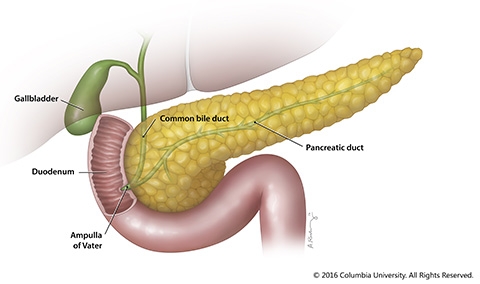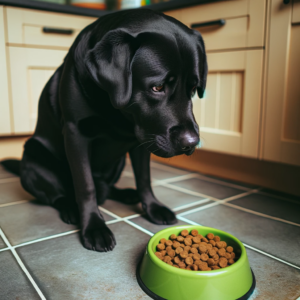Dogs and cats suffer pancreatitis to a disgracefully large degree, 25 – 50 times more than is seen in humans (from rates of dog pancreatitis in Panagiotis et al. 2008). This is as unnatural as it is disgraceful, considering how painful the issue is for the animal.
There is a lot to cover on this subject, so the articles have been split into three. In part 2, we will discuss the causes of pancreatitis in dogs, and in part 3, we will advise on the best diet and supplements for dogs with pancreatitis.
This article will cover the following:
What Does The Pancreas Do?
The pancreas is a small, solid glandular organ that sits behind the small intestine and the stomach. It has two essential functions: Exocrine and Endocrine.
1. Exocrine function
The pancreas releases digestive enzymes that flow through the main pancreatic duct into the top of the small intestines (duodenum). Here, the enzymes Lipase (for digesting fats), Amylase (for digesting carbohydrates), and Protease (breaks down protein) get to work breaking down food for the body to absorb and use.
2. Endocrine Function
The pancreas’ endocrine function is vital for regulating a dog and cat’s blood sugar levels. The most important of the numerous hormones it produces are insulin and glucagon. Glucagon works to raise blood sugar levels when they drop too low and insulin helps to lower blood sugar levels when they rise. Insulin does this by packing excess sugar into fat storage. It also helps with energy production.

What Is Pancreatitis In Dogs – Types And Symptoms
Pancreatitis means “inflammation of the pancreas.” The pancreas releases digestive enzymes that remain inactive until they pass through the pancreatic duct and into the small intestine. Pancreatitis occurs when these digestive enzymes are activated prematurely before they reach the small intestine; they start to digest before they should, leading to damage inside the pancreas itself and surrounding organs such as the liver, bile duct and abdominal cavity; this stage is termed necrotising pancreatitis.
Two types of pancreatitis can occur in dogs; these are acute and chronic pancreatitis.
1. Acute Pancreatitis
Acute (severe and sudden onset) is crippling and painful. As mentioned above, the digestive enzymes are released prematurely and begin to digest the pancreas and surrounding areas.
Acute pancreatitis is a medical emergency. If your dog experiences a few of the following symptoms (including any 1 of the top 3), you should seek veterinary attention immediately:
- Abdominal pain
- Hunched appearance
- Prayer position – their bottom in the air while their front legs and head are low to the floor
- Loss of appetite
- Vomiting
- Fever
- Diarrhoea – often bloody
- Restlessness
- Dehydration
2. Chronic pancreatitis
Chronic (develops over time) pancreatitis in dogs is where the pancreas is not functioning correctly due to low-grade inflammation; this leaves it unable to release digestive enzymes as it should.
This type of pancreatitis can lead to other health complications, such as exocrine pancreatic insufficiency (EPI) – where the pancreas can no longer produce digestive enzymes.
Symptoms will not appear until 85–90% of the pancreas is shut down (Ettinger et al. 1995). Fewer enzymes mean less fat and protein being digested. Symptoms of chronic pancreatitis are insidious. They’re not as apparent as acute pancreatitis, smouldering under the surface. If you notice these symptoms, book an appointment with your vet.
- Vomiting
- Increase or lack of appetite
- Colitis
- Diarrhoea which is yellowy-grey and oily (due to undigested fats, as fewer enzymes mean less fat and protein is being digested)
- Weight loss
- Poor coat condition
- Flatulence
- Coprophagia – poo eating as a result of nutrient deficiency coupled with the more nutritious stools
Chronic Pancreatitis Is Common In (Dry-Fed) Pets. It Makes An Attack Of Acute Pancreatitis In Dogs Far More Likely…
A crippling bout of acute pancreatitis is unlikely to come as a bolt out of the blue for an otherwise healthy dog with no existing pancreas issues. However, as you will learn below, the majority of (dry-fed) dogs and cats are expected to have pancreas issues by mid age.
When you arrive at your veterinary surgery with a dog suffering from acute pancreatitis, they will often blame “that piece of fat off the steak” you gave him as a treat. However, we know consuming fat doesn’t really spike the blood fat at all, not when compared, to the effects of a high carbohydrate diet.
Yes, rather paradoxically, studies show it is the high carb diets that are doing the pancreatitis damage to cats and dogs, leaving the organ under such strain that the lightest of stressors (be it an infection, period of stress or one little lump of fat) can trigger an attack. The classic straw that broke the camel’s back situation.
(More on causes of pancreatitis in dogs in part two).

How Is Pancreatitis In Dogs Diagnosed?
The most common way to confirm a diagnosis of pancreatitis is through a blood test, looking for the elevation of pancreatic-specific enzymes, particularly high levels of serum amylase and serum lipase.
Although these enzymes may be elevated when pancreatitis is present, they are now not thought to be the best or most reliable test of choice for diagnosing pancreatitis in dogs. For example, serum lipase can come from tissues other than the pancreas.
Therefore, a small sample of blood tested for Pancreatic-specific lipase is a much more reliable indicator of pancreatitis, as this form of lipase is specific to the pancreas, and high levels of these are only found in the blood when the pancreas is inflamed.
A vet will often perform a complete blood count to help diagnose pancreatitis in dogs, this may show raised white blood cells, but this does not always point expressly to pancreatitis; there could be several other reasons. An abdominal radiograph can also detect abnormalities in the pancreas. Abdominal ultrasound can also determine the state of the pancreas; if, for example, the pancreas appears inflamed, this will lead to a further indication of pancreatitis.

Prevalence of Pancreatitis in Dogs and Cats
In a study of 73 dogs presented for post-mortem examination, 64% of pancreata displayed evidence of chronic pancreatitis (Newman and Woosley 2004). The very same is seen in cats. Examination of 115 feline pancreata from healthy and sick cats found pancreatitis in 67% of cases, including 45% of apparently healthy cats (Owens et al. 1975, Macy 1989, Steiner and Williams 1997, De Cock et al. 2007).
So, why are so many pets suffering from pancreatitis? Our next article delves into the many causes, the top culprit being a high carbohydrate, ultra-processed, dry food diet.
Treatment For Pancreatitis In Dogs
1. Acute Pancreatitis – Veterinary attention is vital
If your dog is suffering from acute pancreatitis, there is no doubt that this requires veterinary attention immediately. The quicker you get to the vet, the better the outcome will be for your dog.
The vet may administer analgesics to help relieve your dog of the intense pain that comes with this condition. They may even be hospitalised for a few nights and given medication and intravenous fluids to rebalance fluid and electrolyte loss (from vomiting and diarrhoea).
2. To fast or not to fast…?
The old school of thought was always to fast a dog with acute pancreatitis, that feeding would stimulate pancreatic activity in an already inflamed organ. However, fasting is no longer considered the best way to help them recover. Early intervention with good nutrition keeps the gastrointestinal tract healthy and can even lessen the time the animal spends in the hospital. Offer small meals, little and often. Bland, digestible meals, lower in fat while suffering from pancreatitis. More detail on exactly what to feed in part 3.
3. Chronic pancreatitis – stop feeding dry food!
When it comes to chronic pancreatitis, you must stop feeding ultra-processed, high carbohydrate-based dry food. Instead, move on to a real, fresh food diet (especially some fresh pancreas) and some of nature’s excellent anti-inflammatories to cool everything off. Check out our dietary advice for Pancreatitis in dogs.

FAQ
1. What toxins cause pancreatitis in dogs?
Flea treatments, wormers, kennel cough and most certainly annual boosters for viruses after one year of age are unnecessary chemical insults that are rife with side effects and antagonise the immune system. In addition, common anti-inflammatory drugs such as corticosteroids can also cause inflammation in the pancreas. Other toxins, such as Salmonella and Legionella, can cause pancreatitis in dogs.
Vitally, a chronically sick gut can cause problems, and a leaky gut can spread pathogenic bacteria to the pancreas. If your dog is chronically sick, I strongly recommend you read the most popular article on our website, allergies in dogs. It explains not only what is going on but, crucially, how to fix it, avoid the threat of pancreatitis in dogs and the need for potent immunosuppressants in the future.
2. What is the prognosis of pancreatitis in dogs?
Most dogs with mild pancreatitis have a good prognosis if treated correctly and quickly. Also, diet is imperative here, folks – Meals need to be smaller, more often (3-5 times a day), and easily digestible – raw or lightly cooked meat, no processed dry or canned foods and most definitely no pet store treats.
If the bout of pancreatitis is severe, this may have led to the destruction of many cells that produce digestive enzymes. As a result, the dog may suffer from exocrine pancreatic insufficiency (EPI); the pancreas can longer produce digestive enzymes. The pancreas also has an endocrine function; if cells that produce insulin are damaged, this can lead to diabetes. Early intervention is essential with pancreatitis, so take evasive action now.
3. What will dog pancreatitis treatment cost?
Each case of pancreatitis in dogs is different and unique. You should expect to pay for an initial consultation which can be higher if your dog needs emergency treatment and a stay in a veterinary hospital. There will also be the cost of diagnostics, possible medication and follow-up visits. The cost of treating dogs with pancreatitis can range from several hundred to several thousand pounds.

Conclusion
If your dog has pancreatitis and you would like to know more on how to help support them with good nutrition or you would simply like some assistance with making that switch to real food, we offer consults, and we’d love to help you and your dogs.










